For as long as I have been part of the wider Digital Humanities community, I have felt like an outsider. On the periphery. Not part of the “clique”, although for the most part I have found DH people to be pretty welcoming. So I was a little struck by the reports from the Cologne Dialogue on the Digital Humanities that took place this week, as (according to Twitter) disputant after disputant also claimed to be on the periphery of DH. What is it with this field, that so many of its apparent members claim that they are not part of the “in-crowd?”
I don’t have a full answer to that (for now), but it was a similar thought process that got me to start this blog. I’m a Byzantinist, I’m a computer hacker, I combine the two as often as I can–there are really no grounds here for exclusion. What I did realize is that, more than most geeky pursuits, perceived membership in the “DH club” has almost everything to do with how often and how visibly you speak up.
So, by way of a general introduction, I am going to take a leaf from the book (ebook? blog?) of Melissa Terras, and make a series of posts about the work I have done to date and the publications that my work has led to. Along the way I will check the open-access policy for each of the publishers, and make sure that anything that can be open access is, and post a link to it. Unlike Melissa’s, mine will be a chronological history; given my odd hybrid career, it is best to avoid backtracking. And really I think it is a great idea for us scholars to take advantage of whatever rights our publishers allow us to retain over our own work (which is more than I would have thought, for many journal publishers), and get that work out there and indexed in search engines.
This should be fun! Coming soon: how I ended up learning Armenian, and proof that I am indeed a hopeless nerd.
